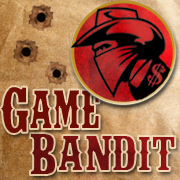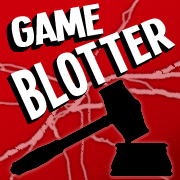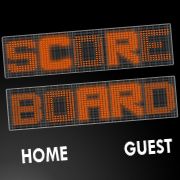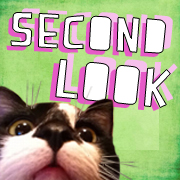 Although I’ve played various versions of Dungeons & Dragons, I’ve never really played in the Forgotten Realms. (Or any of the published settings for that matter, save Planescape and Spelljammer.) But with Wizards of the Coast’s last three adventure campaigns set the Realm’s Sword Coast, I was excited to see what the Sword Coast Adventurer’s Guide had in store for someone running games in the setting.
Although I’ve played various versions of Dungeons & Dragons, I’ve never really played in the Forgotten Realms. (Or any of the published settings for that matter, save Planescape and Spelljammer.) But with Wizards of the Coast’s last three adventure campaigns set the Realm’s Sword Coast, I was excited to see what the Sword Coast Adventurer’s Guide had in store for someone running games in the setting.
Well, that and the book is a Green Ronin product—a company that makes products I enjoy, including spearheading the Out of the Abyss adventure campaign book—and some people that I know worked on this project. Unfortunately, the Sword Coast Adventurer’s Guide isn’t a book I would recommend for players of 5th Edition.
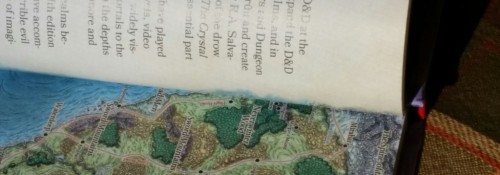
Open the book up to the preface and you see on the right-side page a map of the Realms, extending through the gutter to the margins of the left page. Interesting, but it’s poorly executed. To someone new to the setting—players who have only encountered the Sword Coast through the Starter Set, the three campaign books, or the organized play games — the Sword Coast is their reference point to the Realms. The Sword Coast falls in the gutter, swallowed up by the binding and thickness of the book’s signature. There’s “Neverwin” if you fold the page back far enough. The “Mer…ead Men”. “Luskan ford crossing”.
The map also raises another question: why is it even here? To show how large the Realms are? Well, it cuts off all the Dalelands — pretty much everything east of Cormyr is off the page and the place where the Fifth Edition’s adventures take place isn’t readable. The book is called the Sword Coast Adventurer’s Guide, so why not show off a map of just that area? There is no overall Sword Coast map in the book, just this map of the continent and closeups from it scattered throughout the book. (The map and map segements are done by Mike Schley, who has contributed to most of the 5e line. The full map can be purchased at his site for download.)
I’m spending too much on page 5. Let’s move on.
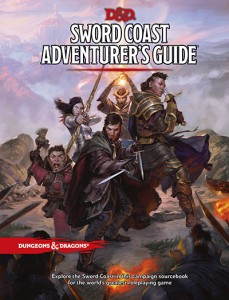 The next section contains incredibly brief passages on areas of the Realms: two paragraphs for The Dalelands (all of them), one on Chessenta, the four nations that make up the Cold Lands get two. There’s a very brief history of the Realms, followed by a lengthy listing of the major deities of the setting. Do you have any of the earlier editions of the setting boxed sets or sourcebooks? More importantly, do you have access to a Forgotten Realms wiki? Not even a minute of searching landed me at the entry for Malar on a Forgotten Realms wiki, which had more information on the Beastlord than this sourcebook.
The next section contains incredibly brief passages on areas of the Realms: two paragraphs for The Dalelands (all of them), one on Chessenta, the four nations that make up the Cold Lands get two. There’s a very brief history of the Realms, followed by a lengthy listing of the major deities of the setting. Do you have any of the earlier editions of the setting boxed sets or sourcebooks? More importantly, do you have access to a Forgotten Realms wiki? Not even a minute of searching landed me at the entry for Malar on a Forgotten Realms wiki, which had more information on the Beastlord than this sourcebook.
Page 43 gets us to a section that’s about the Sword Coast… and the North? Okay, so much more than just the Sword Coast, although the we’re really looking at the cities of the Lord’s Alliance in the Sword Coast region covering the top four inches by one-and-a-half inches of that full-page map. Some cities are shown on callout maps, none of the dwarfholds are. This section is full of in-character recollections of various areas by different adventurers, but they feel like they’re written by the same person. This is the only section of the book that is in first person, and some of the entries in this section can have pages go by between sentences where the fictional author inserts themselves, letting you forget that it’s written in first person. If you want overviews of some of the cities and areas (and don’t have access to a wiki), this is a decent section. But there’s no really deep drill-down into the entries. Don’t expect to run a game set in Daggerford based solely on the information here. Consider this more a “Rough Guide to Faerûn” than a detailed setting bible.
This seems unsatisfying, and it feels that opening up the scope of the setting book from just the Sword Coast to take in all of the area of the North in sixty pages is to blame. If those pages were devoted to just the Sword Coast section (Waterdeep and Daggerford on up north, inland to The High Forest), we’d have a book that has more information about that area. As it is, there’s a lot of high-level information that can be easily found elsewhere. However, the sections at the back of the book appear to be more useful for a setting sourcebook.
The Races of Faerûn chapter is more of how various races fit into the setting. Actual game mechanics amount to sentences like “Sun elves have the racial traits of high elves in the Player’s Handbook” or small sidebars. Tieflings start to branch out to the variety of the “race” from the AD&D Planescape days, instead of demonic half-breeds.
The Classes chapter has a few ways to customize your character, but most seem to be a veneer over the actual class customizations in the Player’s Handbook: This monastic order follows this path in the Player’s Handbook. This druidic group follows this circle found in the Player’s Handbook. This paladin order follows this order in the Player’s Handbook. There are a few things that are neat here: an actual new order for Paladins, two Rogue archetypes, a new patronage path for Warlocks, and a fourth edition Warlord-like archetype for Fighters.
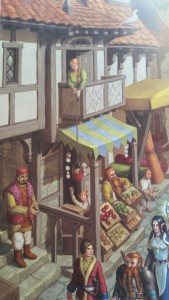 More backgrounds in the aptly-named Backgrounds chapter, but the most fascinating thing here is the M C Escher-level wackiness in the artwork introducing this chapter. There’s a Faction Agent background, but I was under the impression from the Starter Set and the various published campaigns that the five factions in the game were things that the characters join up with as the game goes on. But here, you can choose to be part of The Lord’s Alliance from the get-go. As with the races and classes, many references here to use the traits, ideals, and bonds from exisiting backgrounds in the Player’s Handbook. (Of the twelve background options, only one has a set of these.)
More backgrounds in the aptly-named Backgrounds chapter, but the most fascinating thing here is the M C Escher-level wackiness in the artwork introducing this chapter. There’s a Faction Agent background, but I was under the impression from the Starter Set and the various published campaigns that the five factions in the game were things that the characters join up with as the game goes on. But here, you can choose to be part of The Lord’s Alliance from the get-go. As with the races and classes, many references here to use the traits, ideals, and bonds from exisiting backgrounds in the Player’s Handbook. (Of the twelve background options, only one has a set of these.)
Anyway, that’s the book.
This is a book that wanted to either be longer to fill out… well, everything, really. Or it wants to be a book that focuses on just the Sword Coast.
I would have a rough time recommending this book—it simply doesn’t do the job it wants to. As a setting guide, you can get more out of the Dessarin Valley section in Princes of the Apocalypse to run a whole campaign from. The book doesn’t do much more than a basic wiki for the Realms does, except for the backgrounds and some of the class options. There’s nothing particularly compelling about the Sword Coast Adventurer’s Guide that requires an immediate purchase. A better use of your gaming dollars: buy Mike Schley’s map at his site, and pick up either Princes of the Apocalypse or Out of the Abyss to get enough setting material to run your own overland (Princes) or Underdark (Abyss).
The Sword Coast Adventurer’s Guide retails for $39.95 and is available now.
A copy of the Sword Coast Adventurer’s Guide was provided free by Wizards of the Coast for review purposes.
Trending
- Massdrop.com
- Oh the Irony—Illuminati Card Game Continues to Inspire Conspiracy Theorists
- Footprints, an Educational Ecology Game
- USPS Adds Board Game Flat Rate Box
- Home
- Baila, the Estonian Drinking Card Game
- Crystal Caste Wins Dice Patent Suit Against Hasbro
- Hasbro and Mattel Merger?
- Are Board Games Dangerous?
- Board Games Based on Hindu Mythology
Archives
Most Popular Articles
- Oh the Irony—Illuminati Card Game Continues to Inspire Conspiracy Theorists
- The 20 Most Valuable Vintage Board Games
- The Truth About Dominoes On Sunday in Alabama
- Sequence Game, and Variants
- USPS Adds Board Game Flat Rate Box
- Baila, the Estonian Drinking Card Game
- The 13 Most Popular Dice Games
- Are Board Games Dangerous?
- Guess Who? The Naked Version
- What Happened to the Jewel Royale Chess Set?
Recent Posts
- Toy Fair 2019—Breaking Games
- Talisman Kingdom Hearts Edition
- Toy Fair 2019—Winning Moves
- Toy Fair 2019—Games Workshop
- Toy Fair 2019—Star Wars Lightsaber Academy
- Toy Fair 2019—Stranger Things Games
- Toy Fair 2019—HABA
- Licensing Roundup
- Game Bandit
- 2018 A Difficult Year For Hasbro But Not For D&D Or MtG
Recent Comments
- on Toy Fair 2019—Winning Moves
- on Game Bandit
- on Second Look—Dungeons & Dragons Waterdeep Dragon Heist
- on Crowdfunding Highlights
- on Beyblade SlingShock
- on Game Bandit
- on Game Bandit
- on Watch This Game!, the Board Game Review Board Game
- on Second Look—Vampire: The Masquerade 5th Edition
- on Palladium Books Loses Robotech IP License, Cancels Five-Year-Overdue Robotech RPG Tactics Kickstarter

